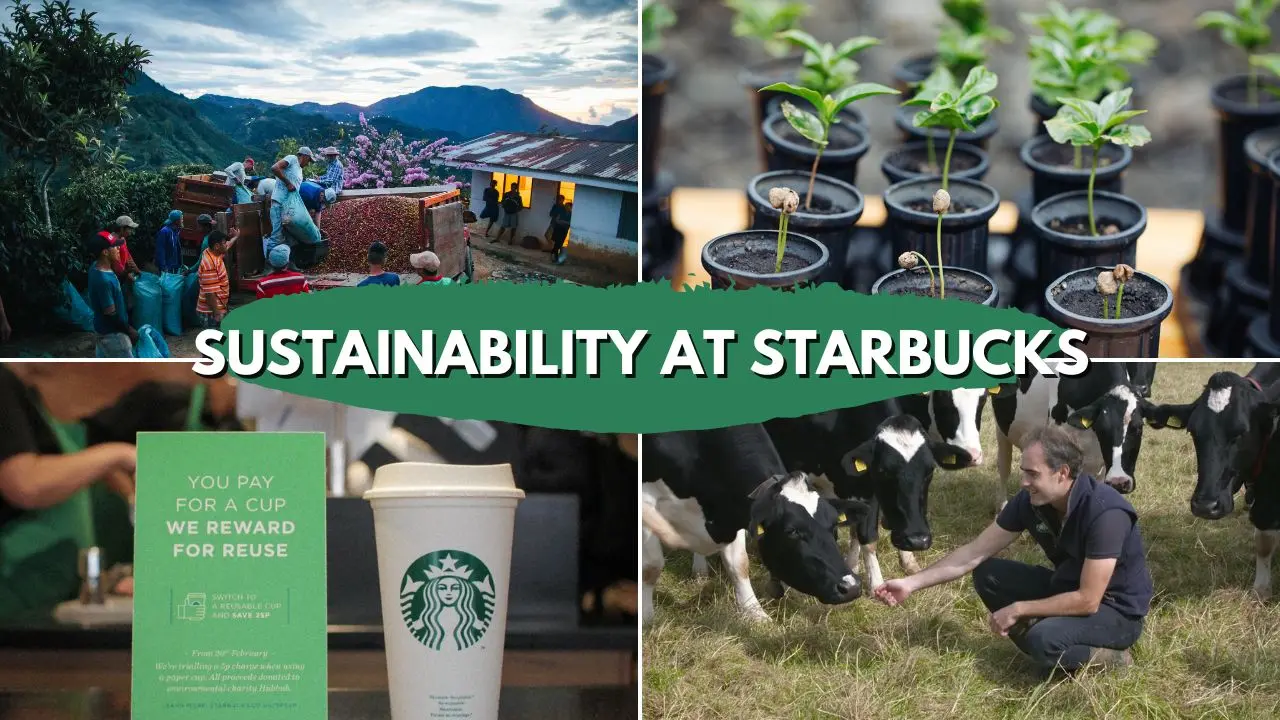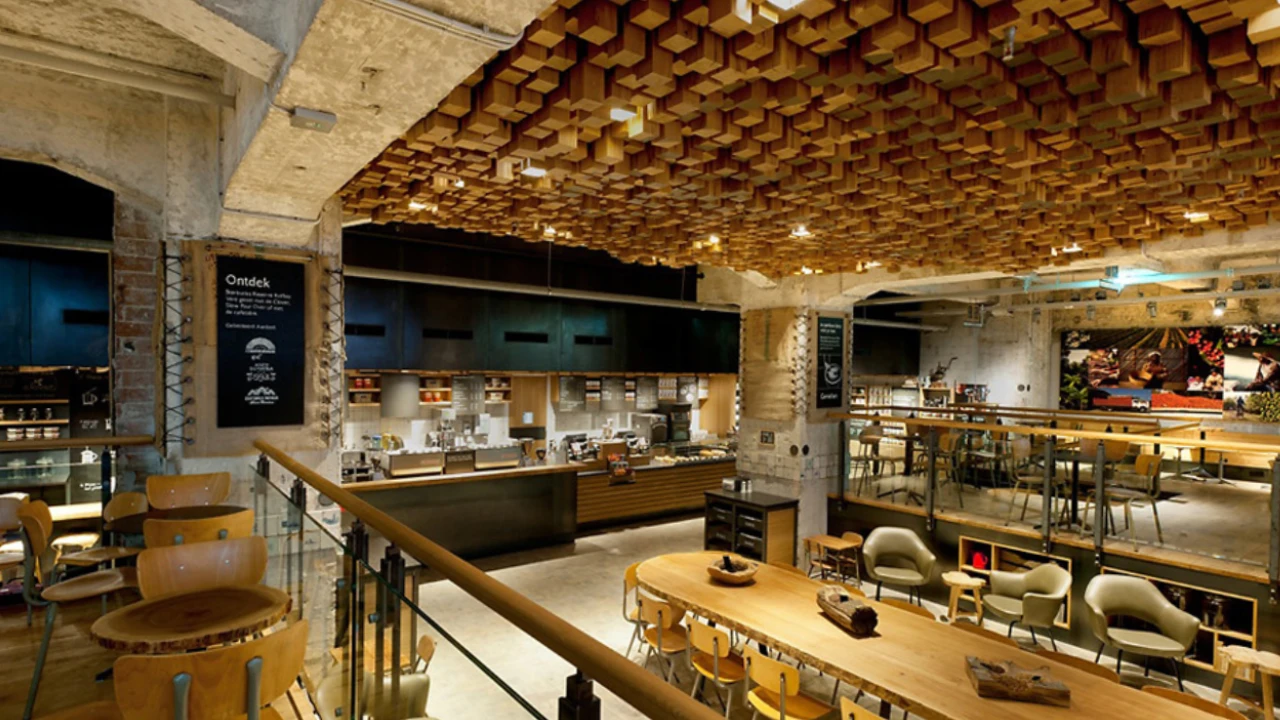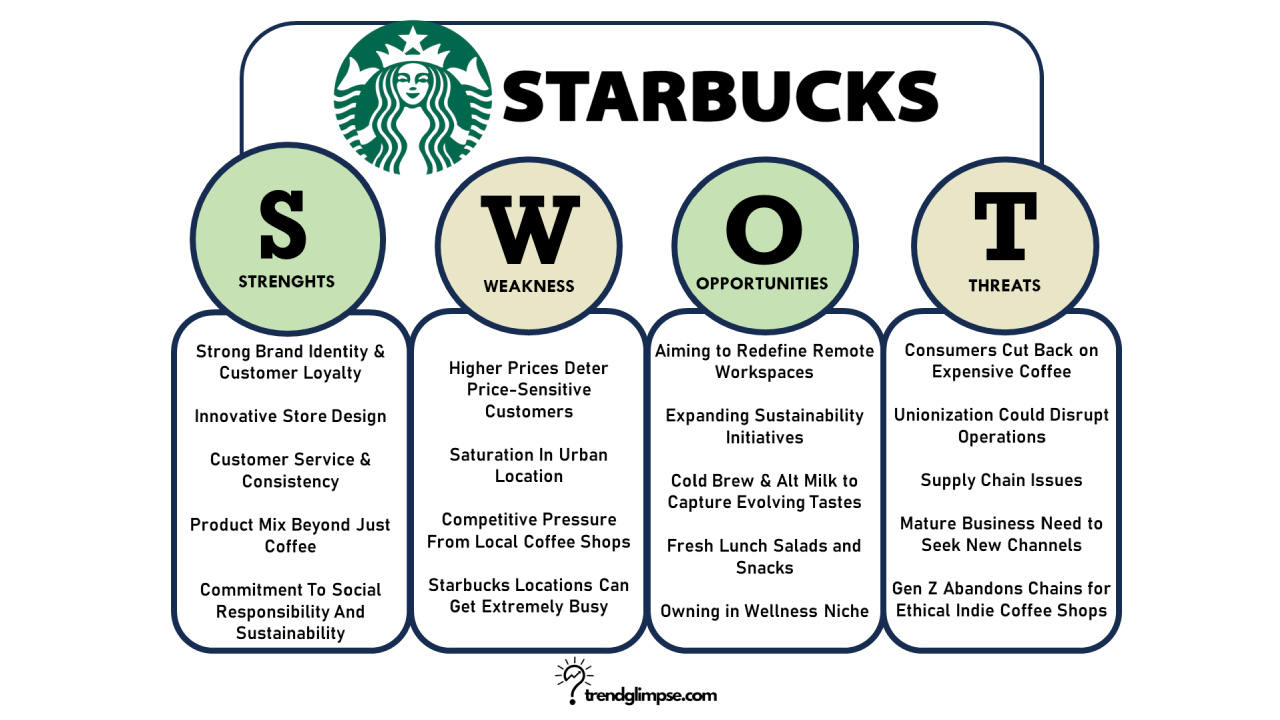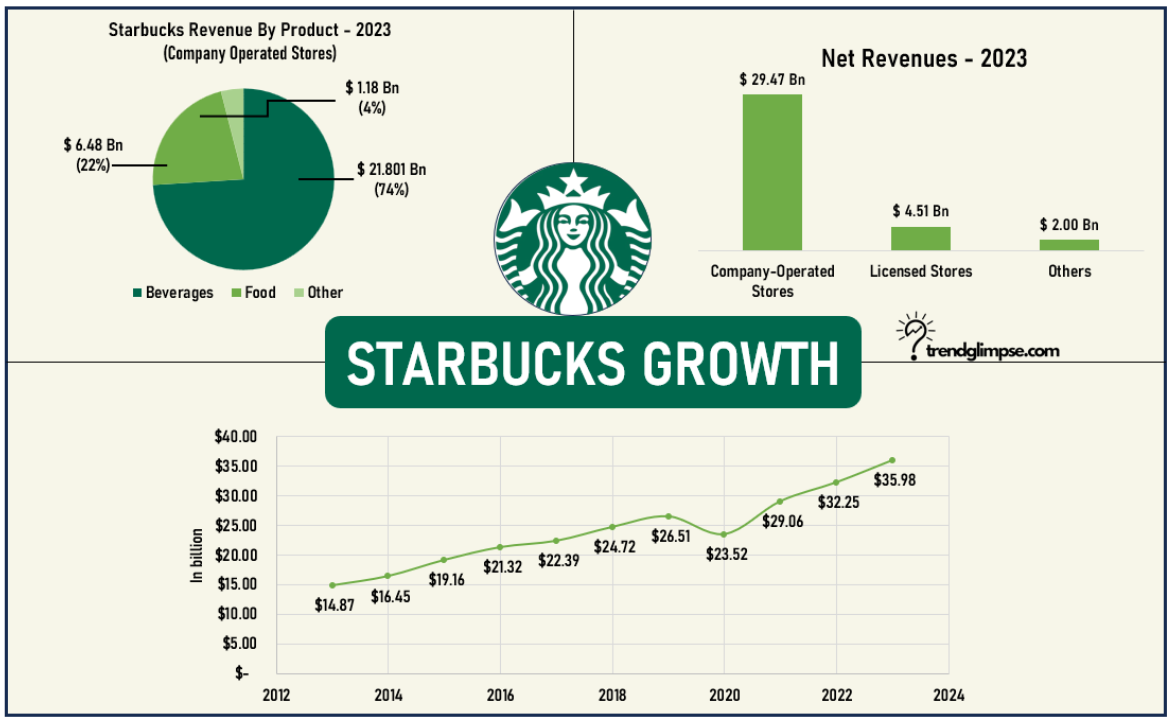An Overview of Starbucks
When it comes to coffee, very few brands are as iconic as Starbucks. Those green mermaids on every cup have become a global symbol of a high-quality coffee shop experience. Today, Starbucks has over 35,000 stores across the world spanning from Shanghai to São Paulo – and almost every city in between.
The key ingredients driving Starbucks’ success? For starters, revenues have climbed to nearly US$ 35.98 billion annually in 2023, on the back of massive retail expansion and loyal customers. In 2021 alone, Starbucks opened 1,173 net new stores, one step closer to their goal of 55,000 total stores worldwide. At the same time, over 19 million Starbucks Rewards members in the US help power repeat purchases.
At the same time, Starbucks faces fierce competition as more specialty coffee chains emerge. And it has to manage fluctuating supply costs, especially for coffee beans. But its sheer size and smart loyalty programs help give it an edge. For example, over 19 million Starbucks Rewards members in the US alone contribute a substantial chunk of sales.
And here’s a fun fact about the emerald empire – did you know Starbucks spends more annually on employee healthcare benefits than on coffee beans? From part-time baristas to corporate staff, Starbucks views employees as critical assets worth investing in. This links to the company’s emphasis on social responsibility and focus beyond just financial metrics.
SWOT Analysis of Starbucks
This Starbucks SWOT analysis will outline the coffee retailer’s most integral positives and negatives to consider as it plans moving forward. Analyzing Starbucks through the SWOT framework provides clarity into the ongoing challenges and advantages facing one coffee’s best-known brands as competition heats up and customer tastes evolve.
Strengths of Starbucks
Strong Brand Identity & Customer Loyalty
Starbucks has built an iconic brand identity and inspired deep customer loyalty over its 50 year history. With consistent branding, top-notch customer service, and innovative offerings, Starbucks has cultivated a community experience that keeps customers coming back and fuels brand devotion. This grants Starbucks both premium pricing power and resilience against competitors.
Innovative Store Design
Staying on the cutting edge, Starbucks stores offer a sleek, modern atmosphere with community tables, lounge spaces, and design touches that elevate the in-store experience. Features like free wifi and power outlets accommodate today’s on-the-go lifestyle. With over 15,000 US locations, Starbucks invests heavily in creating destination retail spaces that entice customers and reinforce its brand image as an innovative leader.
Customer Service & Consistency
Starbucks places immense focus on customer service through extensive employee training to create a welcoming, personalized experience at every visit. Coupled with remarkable consistency across its global locations, Starbucks has built trust in always receiving the same high-quality products and hospitality. This reliability and human connection build lasting bonds with customers.
Product Mix Beyond Just Coffee
Diversifying from just coffee and espresso beverages, Starbucks has grown its menu across food, tea, refreshers, alcohol, and more. This provides greater customer convenience and reasons to return throughout the day or week. Innovations like mobile ordering and packaged goods in grocery stores also increased Starbucks’ reach and evolved its positioning as a lifestyle brand.
Commitment To Social Responsibility And Sustainability
With progressive policies around sustainability, ethical sourcing, and community engagement, Starbucks works to make positive contributions on issues connected to its business. Efforts like reducing water usage and waste as well as championing causes valued by its customer base like gender equity and racial justice help attract and retain both purpose-driven customers and employees looking to align work and personal ethics. This provides a competitive edge in today’s socially-conscious environment.
For Instance, Starbucks has launched its first Greener Store in Taiwan, called Shalu Beishih, as part of its global initiative to reduce carbon emissions, water consumption, and landfill waste by 2030. The store offers unique products, including a specially designed Starbucks Card that complements the store’s architecture.

Greater Global Reach
Starbucks has, by far, the largest global reach in the coffeehouse sector. Leveraging familiar branding, customizing regional offerings, and standardizing key elements like quality and atmosphere give Starbucks a major growth advantage internationally. China, in particular, represents a massive opportunity, with new store openings there accelerating.
New Seasonal Drinks And Limited Time Offers
Starbucks regularly introduces seasonally-themed and limited time beverage offerings, driving excitement and sales. Recent popular examples are their annual Holiday drinks menu and special Easter-time treats. These innovative offerings attract new customers while surprising and delighting loyal fans with fresh takes on established favorites. Moreover, In December 2023, Starbucks introduces a limited-time holiday drink called Merry Mint Mocha. Moreover to promote online ordering, Starbucks kept the drink App Exclusive.
Offers Mobile Ordering And Payment Options
Embracing mobile technology for enhanced speed and convenience is a Starbucks strength. Their well-established app handles payments and also allows customers to pre-order and skip the line. With over 26 million Starbucks Rewards members, mobile ordering and payment integration builds loyalty through ease and personalization based on purchase history. This tech-forward focus keeps Starbucks competitive.
You Might Also Like – HelloFresh Business Model
Weakness of Starbucks
Higher Prices Deter Price-Sensitive Customers
Starbucks charges premium prices for its coffee and food items, with a typical cup of coffee costing $2-5. This deters some price-sensitive consumers, especially in the current high inflation economy. Competitors like McDonald’s offer coffee for under $2, capturing budget-minded coffee drinkers seeking an affordable caffeine fix.
Saturation In Urban Locations
Starbucks aims to have a location on every corner, but this saturation comes with diminished returns. As one Los Angeles neighborhood had 28 Starbucks within a 1.5 mile radius, cannibalizing its own customer base. More choices don’t always bring more customers when stores simply steal business from one another.
Competitive Pressure From Local Coffee Shops
Independent cafes offer greater product diversity and non-standardized experiences. Consumers wanting more unique offerings – like exclusive roasts or specialty baked goods – increasingly opt for these neighborhood spots. Additionally, local loyalty and community connections help smaller stores retain business against corporate chains.
Starbucks Locations Can Get Extremely Busy
Success has its downsides, as popular Starbucks stores struggle with long lines and crowded seating during peak times. Congestion compromises the relaxed café ambiance the brand aims to create. Additionally, overwhelmed baristas may deliver inconsistent or slow service. This frustrates customers seeking convenience and can diminish brand satisfaction long-term if problems persist.
Heavy Reliance on Coffee-Related Products
With over 80% of revenue stemming from coffee products, Starbucks depends tremendously on beans and beverages for success. As consumer tastes evolve, an unbalanced dependence could prove problematic. Rivals like Panera Bread and Pret A Manger offer diverse menus not vulnerable should interest in coffee decline among younger generations increasingly favoring alternatives.
Limited Drive-Thru Presence
Convenient drive-thru windows drive major revenue for chains like McDonald’s and Dunkin’. But Starbucks lacks sufficient drive-up locations – less than 5% of US stores as of 2021 – missing key opportunities to capture busy on-the-go consumers wanting quicker coffee and food pickups. This absence of drive-thru throughput puts Starbucks at a strategic disadvantage versus chains embracing speed and mobility trends.
Environmental Impact of Packaging
Despite sustainability pledges, Starbucks still produces significant cup waste annually. The brand aims for reusable packaging in 10% of sales by 2025, but currently under 4% of drinks are served in customer-owned reusable vessels. As eco-conscious Gen Z’s favor brands demonstrating genuine environmental commitments, Starbucks must substantially reduce its usage of single-use plastics and non-recyclables or risk reputation damage.

Opportunities of Starbucks
Aiming to Redefine Remote Workspaces
With more remote work, Starbucks sees a chance to become the “third place” outside home and office. By enhancing wifi, power outlets, and seating while encouraging campers, Starbucks can meet the demand for flexible workspaces. With over 35,000 stores globally, Starbucks is uniquely positioned to own this niche.
Expanding Sustainability Initiatives
Starbucks aims to cut landfill waste in half by 2030. With reusable cups and strawless lids now the norm, food waste reduction is next. Donating unsold food and converting used grounds into renewable energy and garden soil close the loop. As sustainability matters more to millennials, Starbucks’ efforts reinforce its values-driven brand.
Cold Brew & Alt Milk to Capture Evolving Tastes
With cold brew sales rising over 450% since 2015 alongside alt milk growth, Starbucks is leaning into these trends. Accelerating cold beverage innovation with new recipes and seasonal offerings makes Starbucks a go-to for refreshment. Oatly Oatmilk’s nationwide launch at Starbucks taps into plant-based demand. Meeting shifting preferences boosts loyalty among gen Z and millennials.
Fresh Lunch Salads and Snacks
Lunch and snacking present a major expansion avenue, now contributing over $2 billion annually. New protein-rich salads, savory grain bowls, and grab-and-go sandwiches and snacks meet the desire for fresher, less processed, flavorful fare. These items entice people to visit more while the loyalty program spurs repeat lunch purchases. More daypart opportunities drive incremental sales growth.
Owning Wellness Niche as Competitors Lag on Health
With its focus on real ingredients, transparency and progressive views, Starbucks is already a standout brand for health-conscious consumers. Removing added sugar from iced teas and lemonades while adding more plant-based options solidifies Starbucks’ status as a wellness leader compared to QSR peers like McDonalds. Starbucks’ proactive approach to emerging nutrition issues enhances affinity especially among women and millennials.
Digital and Mobile Ordering Growth
With Mobile Orders surpassing 25% of transactions, Starbucks is leaning into seamless digital experiences to stay ahead. Features like customization, AI recommendations, and rewards integration drive adoption while new payment and pre-order capabilities add convenience. As digital natives comprise an increasing sales mix, flawless technology elevates the brand and drives frequency.
Global Expansion in Untapped Markets
With its 35,000 current stores located primarily across the Americas and China, immense runway remains for international development. Tailoring its store models, menu offerings, and marketing to resonate locally helps unlock new geographies. Partnerships with prominent firms like Tata in India and Nestle for consumer packaged goods boost growth globally.
Innovative Store Concepts
Reimagining its physical footprint, Starbucks is pioneering new retail formats like Pick-up stores, Starbucks Now and urban walk-thrus to align with evolving consumer needs. These smaller footprint stores expand presence rapidly in urban areas and on-the-go settings. Complementing traditional cafes and Drive-Thrus, new concepts unlock more business districts and customize to local tastes.
Threats of Starbucks
In Recession Consumers Cut Back on Expensive Coffee
If the economy enters recession, expensive lattes could be scaled back by more budget-conscious consumers. With an average ticket over $5- $8, Starbucks is vulnerable. Tactics like happy hour discounts and rewards boosting can encourage consumers to still treat themselves even in leaner times. Affordable brewed coffee options are also vital recession tools.
Unionization Could Disrupt Operations & Hurting Perception
A growing unionization movement threatens business continuity with strike risk. Settlements could also inflate costs, impacting profits. Proactively addressing worker concerns regarding pay and safety preempts unrest. Failing to get ahead of unions further damages brand, with majority now viewing Starbucks more negatively. Guarding its progressive reputation is critical. For Instance, Just recently in December 2023, U.S. labor agency, the National Labor Relations Board (NLRB), is pushing Starbucks to reopen 23 stores closed last year, alleging the closures aimed to thwart a nationwide union campaign.
Supply Chain Issues Endanger Coffee Giant
From shipping delays to ingredient shortages, external disruptions frustrate customers and complicate operations. Advanced planning and supplier contracts hedge volatility while inventory buffers ward off stockouts. Circumventing bottlenecks sustains both service and quality that are pillars of the Starbucks experience. Supply chain agility is imperative to managing external uncertainty.
Mature Business Needs to Seek New Channels for Growth
With saturation reaching a tipping point domestically, relying solely on existing stores won’t sustain growth. New channels like delivery partnerships, retail products, and global expansion offer avenues to acquire new consumers. Diversifying beyond the core cafe model opens more horizons for innovation too. These new channels fuel the next chapter.
Gen Z Abandons Chains for Ethical Indie Coffee Shops
Gen Z cares deeply about corporate ethics and sustainability. With smaller carbon footprints and localized ties, independent coffee shops meet their priorities more. Unless Starbucks communicates its own efforts clearly and addresses criticisms around sustainability and commercialization, losing this generation damages longevity. Protecting brand authenticity for young consumers is pivotal.
You Might Also Like – Shake Shack Business Model
Starbucks Business Model
Lets take a deeper look in to Starbucks business model –
| Aspect | Description | Significance |
|---|---|---|
| Product Offering | Starbucks primarily offers a wide range of coffee-based beverages, teas, snacks, and merchandise such as mugs and tumblers. They continually innovate with seasonal and specialty drinks. | The diverse product range caters to varying customer preferences, attracting a broad customer base and encouraging repeat visits. |
| Customer Experience | Starbucks places a strong emphasis on creating a unique and inviting atmosphere in its stores, often referred to as the “Third Place.” This includes cozy interiors, free Wi-Fi, and friendly staff. | A positive and inviting ambiance fosters customer loyalty, encouraging customers to spend more time in stores and become repeat customers. |
| Digital Engagement | Starbucks leverages technology through its mobile app for orders, payments, and loyalty rewards. This includes the popular Starbucks Rewards program, which incentivizes frequent visits. | The digital approach enhances convenience for customers, encourages brand loyalty through rewards, and provides valuable data for personalized marketing. |
| Global Expansion | Starbucks has a widespread global presence with stores in various countries. The company adapts its menu and store design to suit local preferences while maintaining a consistent global brand image. | Global expansion allows Starbucks to tap into diverse markets, adapt to cultural differences, and capitalize on the worldwide popularity of coffee culture. |
| Supply Chain Control | Starbucks maintains control over its coffee supply chain, sourcing high-quality coffee beans through ethical and sustainable practices. This includes programs like C.A.F.E. Practices. | Ensuring a sustainable and ethical supply chain aligns with the values of socially conscious consumers, contributing to positive brand perception. |
| Premium Pricing | Starbucks positions itself as a premium coffee brand, pricing its products higher than many competitors. This premium pricing strategy is supported by the perceived quality of its products and overall experience. | The premium pricing strategy allows Starbucks to invest in quality ingredients, maintain a high level of service, and contribute to its brand image of exclusivity. |
Starbucks Future Growth Opportunities
When you look at the Starbucks SWOT analysis, it’s clear they have some major strengths to leverage for future growth like their brand image, store experience, and customer loyalty program. But the weaknesses and threats highlight areas needing attention too. Going forward, Starbucks can solidify their position by doubling down on digital experiences to engage younger generations through social media campaigns, viral food and beverage offerings, and gamified interactions via their app.
Enhancing mobile ordering and delivery is pivotal too as convenience trends accelerate. From a product perspective, launching more health-conscious menu items and sustainable packaging plays into larger consumer shifts as well. And continued global expansion into emerging markets offers tremendous untapped potential while diversifying geographic risk.

I have always been fascinated by the inner workings of companies and industries. So I decided to study business to explore it more. My goal is to take all my research and turn it into cool stories that give people a better understanding of the business world.



